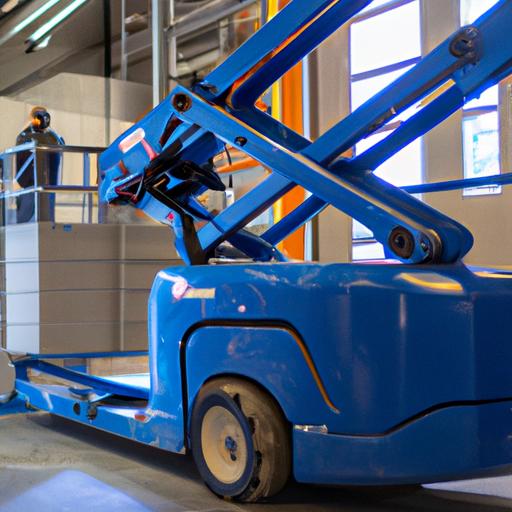How to Operate a Scissor Lift: A Comprehensive Guide
Introduction
Are you ready to elevate your knowledge and master the art of scissor lift operation? Whether you’re a seasoned professional or just starting your career in the construction or maintenance industry, knowing how to operate a scissor lift is essential. In this comprehensive guide, I will walk you through the basics, safety measures, and best practices of operating a scissor lift like a pro.
Importance of Knowing How to Operate a Scissor Lift
Imagine the power of effortlessly reaching high places with ease, gaining access to areas that were once out of your reach. Operating a scissor lift opens up a world of possibilities, allowing you to complete tasks efficiently and safely. By understanding the ins and outs of scissor lift operation, you not only enhance your own skills but also contribute to a safer work environment for yourself and your colleagues.
Brief Overview of Scissor Lifts
Before we delve into the nitty-gritty details, let’s take a moment to understand what a scissor lift is. A scissor lift is a versatile aerial work platform that utilizes a crisscrossing mechanism, resembling a scissor, to elevate workers and their equipment vertically. These lifts are commonly used in construction, maintenance, and warehouse operations, providing a stable platform for working at heights.
As we progress through this guide, you’ll gain insights into the various types of scissor lifts available, safety measures associated with their operation, and step-by-step instructions on how to effectively maneuver them. So, let’s buckle up and embark on this enlightening journey to become a proficient scissor lift operator.
Stay tuned for Section II, where we will explore the basics of a scissor lift, including its components, types, and crucial safety measures. Together, we’ll conquer the heights with confidence!
Understanding the Basics of a Scissor Lift
Definition and Components of a Scissor Lift
Let’s start by unraveling the mystery behind scissor lifts. A scissor lift is a mechanical device designed to provide vertical elevation for workers and their equipment. It consists of a sturdy platform supported by interconnected crisscrossing metal arms, resembling a scissor mechanism. These arms extend and retract, allowing the platform to move up and down smoothly.
To operate a scissor lift effectively, it’s essential to familiarize yourself with its key components. The platform, where you stand or place your equipment, is the heart of the scissor lift. It is typically equipped with guardrails and non-slip surfaces for added safety. The scissor mechanism, located beneath the platform, utilizes hydraulic or electric power to extend and retract, controlling the lift’s vertical movement. Additionally, scissor lifts may have controls, emergency stop buttons, and safety features like sensors to detect obstacles or uneven surfaces.
Different Types of Scissor Lifts
Scissor lifts come in various shapes and sizes, each designed to cater to specific needs. Understanding the different types will help you choose the most suitable lift for your tasks. Some common types include:
-
Indoor Scissor Lifts: These compact lifts are perfect for indoor use, offering maneuverability in tight spaces like warehouses or production facilities.
-
Outdoor Scissor Lifts: Built to withstand rugged terrains and adverse weather conditions, outdoor scissor lifts are ideal for construction sites, maintenance work, or landscaping projects.
-
Rough Terrain Scissor Lifts: Equipped with larger wheels and robust construction, rough terrain scissor lifts provide stability and mobility on uneven or unpaved surfaces.
Safety Measures Associated with Scissor Lift Operations
Ensuring the safety of yourself and others is paramount when operating a scissor lift. Here are some essential safety measures to keep in mind:
-
Pre-Operational Inspections: Before each use, thoroughly inspect the scissor lift for any damages, leaks, or malfunctioning parts. Check the controls, emergency systems, and ensure proper functioning of safety features.
-
Proper Training and Certification: Receive comprehensive training on scissor lift operation, including safety procedures, controls, and emergency protocols. Obtain certification to validate your expertise and compliance with industry standards.
-
Maintaining Stability: Always keep the scissor lift on stable ground, ensuring that it is level and set up on a flat surface. Avoid exceeding the manufacturer’s load capacity and distribute the weight evenly on the platform.
Stay tuned for Section III, where we will delve into the essential steps for preparing and safely operating a scissor lift. Together, we’ll empower ourselves with the knowledge to conquer any elevation challenge!
Section III: Preparing for Scissor Lift Operation
A. Conducting a Pre-Operational Inspection
Before you embark on a scissor lift operation, it’s crucial to perform a thorough pre-operational inspection. This inspection ensures that the lift is functioning optimally and reduces the risk of encountering unexpected issues during operation. Here’s a checklist to guide you through the inspection process:
-
Structural Integrity: Examine the scissor lift for any signs of damage, such as bent or cracked parts. Ensure that all structural components are in good condition.
-
Controls and Safety Devices: Test the controls, buttons, and emergency stop functions to ensure they are responsive and functioning correctly. Verify that safety devices, such as guardrails and safety harnesses, are in place and secure.
-
Hydraulic System: Inspect the hydraulic system for any leaks or irregularities. Check the hydraulic fluid level and ensure it is within the recommended range.
-
Tires and Wheels: Check the condition of the tires and ensure they are properly inflated. Inspect the wheels for any damage or signs of wear.
-
Electrical System: Test the battery level and ensure it is adequately charged. Verify that all lights and alarms are operational.
B. Identifying Potential Hazards and Mitigation Strategies
Operating a scissor lift involves various hazards that can pose risks to both the operator and others in the vicinity. It’s essential to identify these hazards and implement mitigation strategies to minimize the likelihood of accidents or injuries. Consider the following:
-
Uneven Surfaces: Uneven terrain can destabilize a scissor lift. Before operation, survey the work area for any uneven surfaces, holes, or obstructions. If necessary, level the ground or use stabilizers to ensure stability.
-
Overhead Hazards: Be mindful of overhead obstructions like power lines, beams, or tree branches. Maintain a safe distance and always be aware of your surroundings.
-
Weather Conditions: Adverse weather conditions, such as strong winds or rain, can affect the stability and safety of a scissor lift. Avoid operating in extreme weather and follow manufacturer guidelines for safe usage.
-
Fall Hazards: Falls from heights are a significant risk when operating scissor lifts. Ensure that all workers wear appropriate fall protection equipment, such as harnesses and lanyards, and adhere to proper safety protocols.
C. Ensuring Proper Personal Protective Equipment (PPE)
Personal Protective Equipment (PPE) plays a crucial role in safeguarding operators during scissor lift operations. Here are some essential PPE items to consider:
-
Hard Hat: Protect your head from falling objects or potential head injuries by wearing a sturdy hard hat.
-
Safety Harness and Lanyard: When working at heights, always wear a properly fitted safety harness and secure it with a lanyard to prevent falls.
-
Safety Glasses: Shield your eyes from debris, dust, or any potential hazards with impact-resistant safety glasses.
-
High Visibility Vest: Enhance your visibility on the worksite by wearing a brightly colored high-visibility vest, ensuring others can see you clearly.
By conducting a thorough pre-operational inspection, identifying and mitigating potential hazards, and wearing proper PPE, you’re taking important steps to ensure a safe and successful scissor lift operation. In Section IV, we will dive into the details of operating a scissor lift safely, providing you with valuable tips and guidance. Stay tuned!
Operating a Scissor Lift Safely
A. Step-by-step Guide to Starting and Stopping a Scissor Lift
When it comes to operating a scissor lift, knowing the proper steps to start and stop the equipment is crucial. Follow these guidelines to ensure a smooth and safe operation:
-
Before starting the scissor lift, perform a thorough pre-operation inspection. Check for any visible damages, loose parts, or leaks. Make sure all safety features are functional.
-
Once the inspection is complete, ensure the lift is on a level surface, away from any potential hazards. Set the emergency brake and engage the safety controls.
-
Familiarize yourself with the control panel. Most scissor lifts have buttons or switches for raising, lowering, and steering. Refer to the manufacturer’s manual for specific instructions.
-
To start the scissor lift, turn the key or press the power button, depending on the model. Be cautious of any beeping or warning lights, which may indicate a problem.
-
Slowly release the parking brake and verify that all controls are responsive. Test the lifting function by raising the platform slightly to ensure it is working correctly.
-
When you are ready to stop the scissor lift, bring it to a complete stop on a level surface. Engage the emergency brake and turn off the power source. Always follow the manufacturer’s instructions for shutting down the lift.
B. Understanding Scissor Lift Controls and Functions
To operate a scissor lift effectively, it is essential to understand the various controls and functions at your disposal. Here are some key controls commonly found on scissor lifts:
-
Raise and Lower Buttons: These buttons control the vertical movement of the lift platform. Press the raise button to elevate the platform and the lower button to descend.
-
Steering Controls: Scissor lifts are equipped with steering mechanisms to maneuver the equipment. Depending on the model, steering controls can include a steering wheel, joystick, or toggle switches.
-
Emergency Stop Button: In case of an emergency or unsafe situation, locate and press the emergency stop button to immediately halt all operations.
-
Platform Extension: Some scissor lifts have a platform extension feature, allowing you to extend the working area. Familiarize yourself with the controls to safely extend and retract the platform.
Remember, always consult the manufacturer’s manual for specific control functions and guidelines. Practice operating the scissor lift in a controlled environment before using it in actual work situations.
C. Maintaining Stability and Avoiding Tipping Over
Maintaining stability is paramount when operating a scissor lift to prevent tipping over and potential accidents. Follow these tips to ensure a stable and secure operation:
-
Always check the weight capacity of the scissor lift and never exceed it. Consider the combined weight of workers, tools, and materials.
-
Distribute the weight evenly on the platform. Avoid overloading one side, as it can cause instability.
-
Do not extend the platform beyond its designated limits. Overreaching can lead to a loss of balance and tipping over.
-
Be cautious of wind speed and weather conditions. High winds can impact the stability of the lift. If wind speeds exceed the manufacturer’s guidelines, it is advisable to postpone operations.
D. Navigating Obstacles and Uneven Terrain
Operating a scissor lift involves navigating through obstacles and potentially uneven terrain. Here are some strategies to ensure a safe and smooth traversal:
-
Before moving the scissor lift, scan the area for potential obstacles such as debris, overhead hazards, or power lines. Clear the path before proceeding.
-
Slow down when encountering uneven surfaces or ramps. Always approach them at a right angle to maintain stability.
-
If the ground is uneven, use outriggers or stabilizers to level the scissor lift. Engage them as per the manufacturer’s instructions to ensure a secure base.
-
Be mindful of slopes and inclines. Ascend or descend them slowly and cautiously, keeping the scissor lift level to minimize the risk of tipping over.
By following these guidelines for safe operation, you can minimize the risks associated with scissor lift operation and ensure a secure and productive work environment. Stay tuned for Section V, where we will explore the best practices for scissor lift operation, including safe work practices, maintenance, and training requirements. Together, we’ll elevate your skills and knowledge to new heights!
Section V: Best Practices for Scissor Lift Operation
A. Implementing Safe Work Practices and Procedures
When it comes to operating a scissor lift, safety should always be the top priority. Here are some best practices to ensure a safe working environment:
- Conduct a thorough risk assessment before starting any task. Identify potential hazards and develop a plan to mitigate them.
- Always follow manufacturer guidelines and operating instructions. Familiarize yourself with the specific controls and functions of the scissor lift you are operating.
- Inspect the work area for any obstacles, uneven surfaces, or overhead hazards that could pose a risk during operation.
- Secure any loose materials or tools to prevent them from falling while the lift is in motion.
- Use safety equipment such as harnesses, guardrails, and non-slip footwear to minimize the risk of falls.
B. Communicating and Cooperating with Co-workers
Effective communication and cooperation among team members are vital to maintaining a safe and productive work environment. Here’s how you can enhance collaboration:
- Establish clear communication channels with your co-workers. Use radios or hand signals to communicate important instructions or warnings.
- Coordinate with other workers who may be working in the vicinity of the scissor lift. Ensure everyone is aware of the lift’s movements and potential hazards.
- Encourage an open and supportive atmosphere where workers can freely voice safety concerns or suggestions for improvement.
- Stay alert and be mindful of your surroundings. Watch out for other workers, vehicles, or machinery that may be operating nearby.
C. Preventative Maintenance and Inspections
Regular maintenance and inspections play a crucial role in ensuring the safe and smooth operation of scissor lifts. Follow these guidelines:
- Adhere to the manufacturer’s recommended maintenance schedule. Regularly inspect and service the scissor lift to identify and address any potential issues.
- Check the lift’s hydraulic system, electrical components, and structural integrity for any signs of wear or damage.
- Inspect the tires, brakes, and safety features to ensure they are functioning properly.
- Keep a detailed record of all inspections, maintenance activities, and repairs conducted on the scissor lift.
D. Training and Certification Requirements
Proper training and certification are essential for anyone operating a scissor lift. Consider the following:
- Receive comprehensive training on the safe operation of scissor lifts from a certified instructor or training program.
- Obtain the necessary certifications or licenses required by your jurisdiction or workplace.
- Regularly participate in refresher courses to stay updated on the latest safety regulations and best practices.
By implementing these best practices, you’ll create a safer work environment, reduce the risk of accidents, and ensure optimal performance of scissor lifts. Stay tuned for Section VI, where we will wrap up this guide with a recap and some final thoughts on operating a scissor lift.
Conclusion
As we reach the end of this comprehensive guide on how to operate a scissor lift, it’s evident that acquiring the necessary knowledge and skills in scissor lift operation is crucial for a safe and successful work environment. By following the best practices, adhering to safety guidelines, and undergoing proper training and certification, you can ensure not only your own well-being but also the well-being of those around you.
Remember, the importance of regular training and staying up-to-date with the latest safety protocols cannot be emphasized enough. Operating a scissor lift requires expertise, precision, and a thorough understanding of the equipment. By regularly refreshing your knowledge and skills, you’ll be better equipped to handle any challenges that may arise.
Throughout this guide, we have covered the basics of a scissor lift, the importance of knowing how to operate one, and the essential safety measures to keep in mind. We’ve also explored step-by-step instructions, best practices, and the significance of communication and cooperation with your colleagues.
Now, armed with this knowledge, it’s time to put it into practice and soar to new heights in your scissor lift operation endeavors. Remember, safety should always be your top priority. So, buckle up, follow the guidelines, and let your skills shine as you confidently navigate the world of scissor lift operation.
Thank you for joining me on this journey. May your scissor lift operations be smooth, efficient, and accident-free. Stay safe, keep learning, and enjoy the empowering experience of operating a scissor lift!
Stay tuned for more informative guides and resources to further enhance your expertise.






